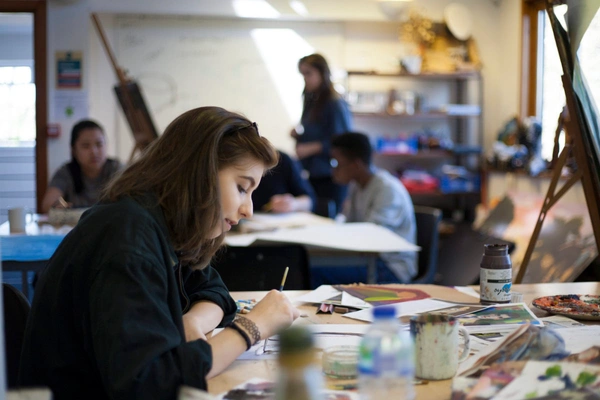History of Art
Masterpieces and movements
At RIC, diving into the world of Art History at A level isn't just about memorizing dates and names – it's a journey through the tapestry of human civilization, where each brushstroke and architectural flourish tells a story and you'll develop new ways of seeing.
We'll unravel the intricate links between society and art, from the grandeur of Renaissance masterpieces to the shock of the new in modernism and the raw expressionism of contemporary works. You'll master the lingo of art history, from chiaroscuro to postmodernism, and explore the seismic shifts in cultural, social, and political landscapes that have shaped artistic expression throughout the ages.
But this isn't just about pictures – it's about honing your critical eye and unlocking the secrets hidden within sculpture and architecture as well. Whether it's deciphering the symbolism of a Renaissance altarpiece or decoding the subversive messages of a Banksy mural, you'll emerge with a toolkit of visual and analytical skills that'll serve you well in any path you choose.
And let's not forget the power of art to shape our worldviews and identities. From the propaganda of totalitarian regimes to the revolutionary fervor of the avant-garde, you'll explore how images and architectural edifices have been wielded as tools of persuasion and resistance throughout history.
Best of all, this course isn't just an academic exercise – it's a gateway to a world of possibilities. Whether you're dreaming of pursuing a degree in art history or forging a career in the creative industries, the skills and knowledge you'll gain here will set you on the path to success.

I hate flowers. I paint them because they're cheaper than models and they don't move.
Exam Specification
Paper 1 – Visual Analysis and Themes
Visual Analysis
For each of the following types of art and architecture, students answer a single compulsory question that requires them to comment on an unseen photograph of:
a painting
a sculpture
a building
Themes
Choose two themes from a choice of three:
Nature in art and architecture
Identities in art and architecture
War in art and architecture
Paper 2 – Periods
Choose two periods from a choice of five:
Invention and illusion: the Renaissance in Italy (1420‒1520)
Power and persuasion: the Baroque in Catholic Europe (1597‒1685)
Rebellion and revival: the British and French Avant-Garde (1848‒99)
Brave new world: Modernism in Europe (1900‒39)
Pop life: British and American contemporary art and architecture (1960‒2015)
Curious about Art History?
Read
E H Gombrich (2006) The Story of Art, Phaidon
An accessible introduction to art history from early cave paintings to the late 20th Century. The main focus is on European and American art. Gombrich makes interesting connections between different art historical periods and styles, creating a narrative that reveals how artists have responded to the work and ideas of previous generations.
P Huntsman (2016) Thinking About Art, Wiley Blackwell
Written specifically for A Level History of Art students and providing a comprehensive introduction to the concepts studied, including genre, visual analysis and social and cultural contexts.
R Hughes (2002) The Shock of the New, Thames and Hudson
A history of 20th Century art from cubism, to pop art, to later developments such as performance art and land art. It accompanies a TV series that’s available on YouTube.
J Berger (2008) Ways of Seeing, Penguin
The book explores how we look at paintings and other images and comments on the ideologies underpinning representation. The chapter on the female nude was particularly influential. This book also accompanies a TV series, available on YouTube.
Watch
Tim Marlow has presented various programmes, including Great Artists (2001-3)(episodes on Turner, Titian and Rodin are particularly relevant to what we will be studying), The Nude in Art (2015) and The Impressionists (1999)
Simon Schama (2006) The Power of Art, BBC
A series exploring eight ground-breaking works that Schama argues changed the history of art and responded powerfully to the times in which they were made. Particularly relevant to our study are episodes on Turner Van Gogh and Picasso.
Listen
Art Curious podcast http://www.artcuriouspodcast.com
An exploration into the juicier side of art history answering such questions as did Van Gogh actually commit suicide? Was a British painter really Jack the Ripper? And how did the rivalry between Michelangelo and Raphael produce one of the best works of art ever?
Hannah Gadsby: Arts Clown https://www.bbc.co.uk/programmes/b0551t35/episodes/player
A humorous, but insightful exploration of key artworks. She has also performed stand up on art.
Online
Smarthistory https://smarthistory.org/about/
Videos and essays from art history academics covering a wide range of eras and styles, with some sections specifically written to support the A-Level specification.
The Art Story https://www.theartstory.org/
A collection of material categorised by artist, era, movement and ideas, for example, sections on the sublime, feminist art and formalist approaches to art.
Google Arts and Culture https://artsandculture.google.com/
An online platform where you can view high-resolution images and videos of artworks and cultural artefacts from around the world. The website allows you to zoom in to artworks, so you can see great detail such as brushstrokes and tool marks. Additional material includes educational videos, art history timelines and art toolkits.
Museum and gallery sites have information on artworks and educational resources. Examples include The Tate (https://www.tate.org.uk/), National Gallery (https://www.nationalgallery.org.uk/) MOMA (https://www.moma.org/) and The Pompidou Centre https://www.centrepompidou.fr/en
Subject introduction by Robin Macintosh, Head of Art at RIC